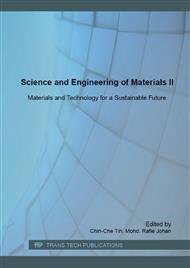p.67
p.73
p.77
p.83
p.89
p.97
p.101
p.107
p.112
Surface Morphology Analysis and Mechanical Characterization of Electrospun Nanofibrous Structure
Abstract:
The extraordinary properties of nanofibrous structure have gained ever-increasing appeal as an attractive candidate in a myriad of applications, especially for the water filtration. This type of structure has permeability due to its porous structure. Electrospinning is one of the most viable approaches in fabricating nanofibrous web that exhibits novel and outstanding performance in membrane separation as compared to those produced through conventional methods. Thus, the optimization of electrospinning processes is actively pursued by many researchers in order to obtain the best structure suitable for real-life applications. In this study, the surface morphology analysis and mechanical characterization of nanofibrous structure are addressed. For this purpose, polyvinylidene fluoride (PVDF) is considered. The polymeric nanofibrous structures are fabricated through electrospinning technique. Parameters such as polymer concentration and applied voltage for electrospinning process were varied and the resulting morphology of the structure were observed using SEM. In addition, the macroscopic mechanical responses of the structure were probed by means of tensile tests with special attention given to membrane anisotropy and behavior under cyclic loading.
Info:
Periodical:
Pages:
89-93
Citation:
Online since:
July 2016
Keywords:
Price:
Сopyright:
© 2016 Trans Tech Publications Ltd. All Rights Reserved
Share:
Citation:



